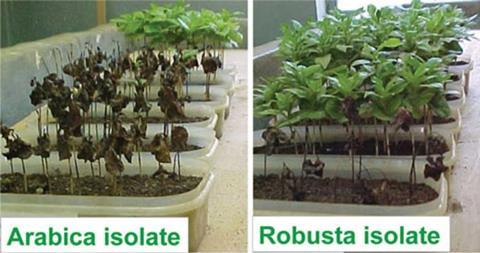During the past century, outbreaks of coffee wilt disease, which are caused by the fungal pathogen Fusarium xylarioides, have severely impacted coffee production across sub-Saharan Africa. Despite being discovered in 1927, little is known about the pathogen’s genetics and evolution, and this understanding is crucial for managing future outbreaks.
In the new study, researchers compared the genomes of 13 historic strains spanning six decades and multiple disease outbreaks to investigate how the pathogen has evolved and adapted to its host plants. They found that F. xylarioides is made up of at least four distinct lineages: one specialized to live on arabica coffee plants, one adapted to robusta coffee plants and two historic lineages that infected multiple coffee species.
The researchers also found evidence that these strains had repeatedly received segments of DNA from another fungal pathogen, F. oxysporum, which enhanced F. xylarioides’s ability to infect coffee plants. These additions of DNA, called horizontal gene transfer, likely contributed to the repeated emergence of coffee wilt disease on the African continent.
Pathogen outbreaks
Previous studies have shown that similar horizontal gene transfer events contributed to new outbreaks of other pathogens, including potato blight, certain wheat fungal pathogens and Aspergillus fumigatus, a fungus that most commonly infects immunocompromised individuals.
READ MORE: The banana apocalypse is near, but biologists might have found a key to their survival
READ MORE: Endophytes colonize and protect coffee seedlings
The researchers concluded that the use of genomics techniques on historical strains of fungi, sampled during the last century and held in culture collections, would provide a powerful way to further investigate the role of horizontal gene transfer in fungal outbreaks.
The authors add: “An historical approach shows the importance of horizontal transfers and large mobile elements in the emergence of new types of disease. If we can understand how new types of diseases evolve, we can give growers the knowledge they need to reduce the risk of new diseases emerging in the first place.”









No comments yet